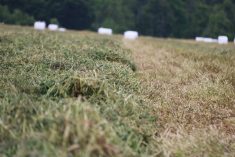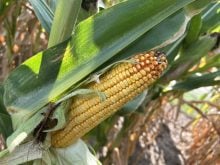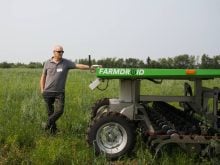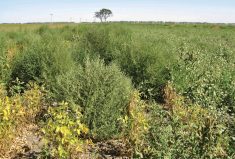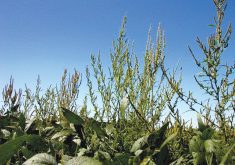An invention originally designed to control European corn borer in potatoes has shown potential to reduce weed seeds during potato harvest.
Dr. Andrew McKenzie-Gopsill, a research scientist with Agriculture and Agri-Food Canada, recently discussed the advantages of minimizing weed seeds during harvest to reduce pressure in potato crops. Then a colleague suggested an invention that could help: the vine crusher.
Why it matters: Options for weed control in potato crops are minimal and new methods are encouraged.
Invented in 2011, the vine crusher is a simple attachment to potato harvesters that helps control overwintering corn borer larvae.
Read Also

Journal pulls long-cited glyphosate study for ethics violations
The journal Regulatory Toxicology and Pharmacology has retracted a 2000 Monsanto-linked glyphosate review, drawing new scrutiny as Bayer faces mounting legal pressure.
“It really is just a set of two metal rollers that spin in on themselves with a set of brushes that feeds the vines through the two rollers,” says McKenzie-Gopsill. The tension between the rollers crushes the larvae within the stalks.
Although the invention showed almost 99 per cent reduction in spring emerging corn borer moths, the crusher wasn’t widely adopted. All growers within an area would have to use it because moths can easily migrate between fields.
But the vine crusher shows potential for harvest weed seed control by crushing seeds during harvest. Potato growers now have only one herbicide option for post-emergent broadleaf weeds, and herbicide resistance is a concern.
“We’re trying to take a more sustainable and long-term approach to weed management. We’re trying to target the weed seed bank. [It’s] a tactic that seeks to either remove or destroy or devitalize weed seeds from the field,” says McKenzie-Gopsill.
He and his research team first focused on lamb’s quarters, a weed that shows the most herbicide resistance.
“We started playing around with [the potato vine crusher] and just started sending seeds through it and seeing if they were able to actually crush them,” he says. “We got about 65 per cent control when we just put lamb’s quarters seed through the system, and then evaluated the germination percent in a petri plate.”
The same level of control was found when the seeds were put through the crusher and placed in sterilized field soil in the greenhouse.
Based on this success, the team started to work with other weeds and found even better results.
“The lowest was 87 per cent control with red root pigweed, and up to 94 per cent control with volunteer canola. So, very high levels of control in our petri plates.”
McKenzie-Gopsill says his team wanted to simulate an actual potato harvest as closely as possible but under controlled conditions.
“We took all of our weed seeds, mixed them up together with some potato biomass and sent that through the rollers and then evaluated the per cent germination.”
Germination rates were reduced for all weed species tested.
“One thing we also found is that you might also be stimulating germination of some of these species, or breaking dormancy by kind of scarifying the seeds, roughing them up,” he says. However, potatoes are harvested in cooler fall temperatures so “anything that might germinate due to us breaking dormancy with this system is going to result in fatal germination.
“You’re trying to actually have an effect on your weed population within a specific field. If you reduce the number of weed seeds that are there, then hopefully you can have a lower weed pressure in subsequent years.”
Although the system isn’t as effective as the Harrington Seed Destructor used by his western colleagues, McKenzie-Gopsill says the vine crusher system had promising results.
“Our system is giving, under conditions of a simulated harvest, around 40 per cent control for most of our [weed] species. There was a paper published by one of the prominent researchers in harvest weed seed control who said that you only need an efficacy of about 20 per cent to maintain pig weed populations.
“We’re above that 20 per cent, which means that in theory, we should be able to … affect weed populations in the long term.”
Use of the potato vine crusher for weed control has yet to be tested in the field but it was effective in field trials against corn borer, the researcher says.
“My hope is that we will test it in field during this potato harvest. The system just goes on the back of a potato harvester. It shouldn’t be too much of a hindrance or a change to how producers are caring about or going about harvesting the crop normally.”
This article originally appeared in Farmtario.



